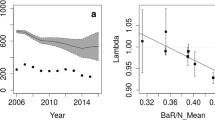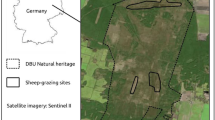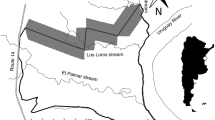Abstract
Given the importance of red deer Cervus elaphus for hunting and conservation purposes, understanding the interactions between this species and its habitats in the Mediterranean region is a crucial step for the sustainable management of this species. Aiming to compare pellet group counts and direct observations methods to study the habitat use and selection by red deer, the results obtained by both methods were compared, and their advantages and disadvantages were discussed. To understand the temporal patterns of habitat use and selection, the survey was conducted at three different seasons, birth period, rut season and winter. The habitat use and selection were studied in relation to land cover, watercourse, roads, ecotone zones and other topographic features (altitude, slope and aspect), using generalized linear models and selection ratios. The similarity of the results provided by pellet group counts and direct observations indicate that both methods may constitute useful tools to study the habitat use and selection by red deer. Globally, red deer seemed to select habitats that provide simultaneously food and some cover, as shown by its preference for shrublands, independently of the sampling season. The positive selection of ecotone zones embodies the need for open spaces. Males and females showed a similar use of shrubland, but selected patches with different characteristics therein. The spatial and temporal patterns exhibited by our results suggest that red deer balance their habitat requirements in respect to each phase of their reproductive cycle. Pellet group counts and direct observations seem to be useful methods to analyze habitat use and selection, and may provide helpful knowledge to the management and conservation of red deer.
Similar content being viewed by others
References
Acevedo, P., Ferreres, J., Jaroso, R., Durán, M., Escudero, M.A., Marco, J., Gortázar, C, 2010. Estimating roe deer abundance from pellet group counts in Spain: An assessment of methods suitable for Mediterranean woodlands. Ecol. Indic. 10, 1226–1230.
Adrados, C, Baltzinger, C. Janeau, G., Pépin, D., 2008. Red deer Cervus elaphus resting place characteristics obtained from differential GPS data in a forest habitat. Eur. J. Wildl. Res. 54, 487–494.
Akaike, H., 1974. New look at statistical-model identification. IEEE Trans. Autom. Control AC 19, 716–723.
Allen, A.M., Månsson, J., Jarnemo, A., Bunnefeld, N., 2014. The impacts of landscape structure on the winter movements and habitat selection of female red deer. Eur. J. Wildl. Res..
Alves, J., Alves da Silva, A., Soares, A.M.V.M., Fonseca, C, 2013a. Pellet group count methods to estimate red deer densities: precision, potential accuracy and efficiency. Mamm. Biol. 78, 134–141.
Alves, J., Alves da Silva, A., Soares, A.M.V.M., Fonseca, C, 2013b. Sexual segregation in red deer: is social behaviour more important than habitat preferences? Anim. Behav. 85, 501–509.
Ament, R., Clevenger, A., Yu, O., Hardy, A., 2008. An assessment of road impacts on wildlife populations in U.S. National Parks. Environ. Manage. 42, 480–496.
Anderson, C.W., Nielsen, C.K., Hester, CM., Hubbard, R.D., Stroud, J.K., Schauber, E.M., 2013. Comparison of indirect and direct methods of distance sampling for estimating density of white-tailed deer. Wildl. Soc. Bull. 37, 146–154.
Anderson, D.R., 2001. The need to get the basics right in wildlife field studies. Wildl. Soc. Bull. 29, 1294–1297.
Apollonio, M., Ciuti, S., Luccarini, S., 2005. Long-term influence of human presence on spatial sexual segregation in fallow deer (Dama dama). J. Mammal. 86, 937–946.
Apollonio, M., Andersen, R., Putman, R., 2011. European Ungulates and their Management in the 21st Century. Cambridge University Press.
Archibold, O.W., 1995. Ecology of World Vegetation. Chapman & Hall, London.
Bailey, D.W., Gross, J.E., Laca, E.A., Rittenhouse, L.R., Coughenour, M.B., Swift, D.M., Sims, P.L., 1996. Mechanisms that result in large herbivore grazing distribution patterns. J. Range Manage. 49, 386–400.
Barbet-Massin, M., Jiguet, F., Albert, C.H., Thuiller, W., 2012. Selecting pseudoabsences for species distribution models: how, where and how many? Methods Ecol. Evol. 3, 327–338.
Barboza, P.S., Bowyer, R.T., 2000. Sexual segregation in dimorphic deer: a new gastrocentric hypothesis. J. Mammal. 81, 473–489.
Barboza, P.S., Bowyer, R.T., 2001. Seasonality of sexual segregation in dimorphic deer: extending the gastrocentric model. Alces 37, 275–292.
Bar-David, S., Saltz, D., Dayan, T., Shkedy, Y., 2008. Using spatially expanding populations as a tool for evaluating landscape planning: the reintroduced Persian fallow deer as a case study. J. Nat. Conserv. 16, 164–174.
Bartos, L., Vankova, D., Miller, K.V., Siler, J., 2002. Interspecific competition between white-tailed, fallow, red, and roe deer. J. Wildl. Manage. 66, 522–527.
Bennett, L.J., English, P.F., McCain, R., 1940. A study of deer populations by use of pellet-group counts. J. Wildl. Manage. 4, 398–403.
Block, W.M., Brennan, L.A., 1993. The habitat concept in ornithology. In: Power, D. (Ed.), theory and applications, Current Ornithology, Springer Verlag, pp. 35–91.
Bobek, B., Boyce, M.S., Kosobucka, M., 1984. Factors affecting red deer (Cervus elaphus) population density in Southeastern Poland. J. Appl. Ecol. 21, 881–890.
Bonenfant, C, Gaillard, J.M., Klein, F., Hamann, J.L., 2005. Can we use the young: female ratio to infer ungulate population dynamics? An empirical test using red deer Cervus elaphus as a model. J. Appl. Ecol. 42, 361–370.
Bonnet, G., Klein, F., 1991. Le cerf. Hatier Éditions S. A. Paris.
Borkowski, J., 2004. Distribution and habitat use by red and roe deer following a large forest fire in South-western Poland. For. Ecol. Manage. 201, 287–293.
Borkowski, J., Ukalska, J., 2008. Winter habitat use by red and roe deer in pine-dominated forest. For. Ecol. Manage. 255, 468–475.
Brinkman, T.J., Person, D.K., Smith, W., Chapin, F.S., McCoy, K., Leonawicz, M., Hun-dertmark, K.J., 2013. Using DNA to test the utility of pellet-group counts as an index of deer counts. Wildl. Soc. Bull. 37, 444–450.
Bugalho, M.N., Milne, J.A., 2003. The composition of the diet of red deer (Cervus elaphus) in a Mediterranean environment: a case of summer nutritional constraint? For. Ecol. Manage. 181, 23–29.
Burnham, K.P., Anderson, D.R., 2002. Model Selection and Multi-model Inference: A Practical Information-theoretic Approac, 2nd ed. Springer, New York, London.
Carranza, J., Hidalgo de Trucios, S.J., Medina, R., Valencia, J., Delgado, J., 1991. Space use by red deer in a Mediterranean ecosystem as determined by radio-tracking. Appl. Anim. Behav. Sci. 30, 363–371.
Clutton-Brock, T.H., Guinness, F.E., Albon, S.D., 1982. Red Deer: Behavior and Ecology of Two Sexes. University of Chicago Press, Chicago.
Edge, W., Marcum, C, 1989. Determining elk distribution with pellet-group and telemetry techniques. J. Wildl. Manage. 53, 621–624.
Forsyth, D.M., Barker, R.J., Morriss, G., Scroggie, M.P., 2007. Modeling the relationship between fecal pellet indices and deer density. J. Wildl. Manage. 71, 964–970.
Fuller, T.K., 1991. Do pellet counts index white-tailed deer numbers and population-change. J. Wildl. Manage. 55, 393–396.
Fuller, T.K., 1992. Do pellet counts index white-tailed deer numbers and population-change: a reply. J. Wildl. Manage. 56,613.
Gaillard, J.M., Hebblewhite, M., Loison, A., Fuller, M., Powell, R., Basille, M., Van Moorter, B., 2010. Habitat-performance relationships: finding the right metric at a given spatial scale. Philos. Trans. R. Soc. Lond. B. Biol. Sci. 365, 2255–2265.
Garín, I., 2000. El ciervo (Cervus elaphus) en la Reserva de Caza de la Garcipollera (Huesca). Consejo de la Protección de la Naturaleza de Aragón Zaragoza.
Gill, R., 1990. Monitoring the status of European and North American Cervids. Global Environment Monitoring System Information Series 8, United Nations Environment programme, Nairobi.
Godvik, I.M.R., Loe, L.E., Vik, J.O., Veiberg, V., Langvatn, R., Mysterud, A., 2009. Temporal scales, trade-offs and functional responses in red deer habitat selection. Ecology 90, 699–710.
Hutto, R.L., 1985. Habitat selection by nonbreeding, migratory land birds. In: Cody, N. (Ed.), Habitat Selection in Birds. Academic Press, Orlando, FL, USA, pp. 455–476.
Jaeger, J.A.G., Bowman, J., Brennan, J., Fahrig, L., Bert, D., Bouchard, J., Charbonneau, N., Frank, K., Gruber, B., von Toschanowitz, K.T., 2005. Predicting when animal populations are at risk from roads: an interactive model of road avoidance behavior. Ecol. Model. 185,329-348.
Jarnemo, A., 2008. Seasonal migration of male red deer (Cervus elaphus) in southern Sweden and consequences for management. Eur. J. Wildl. Res. 54,327-333.
Jiang, G.S., Zhang, M.H., Ma, J.Z., 2008. Habitat use and separation between red deer Cervus elaphus xanthopygus and roe deer Capreolus pygargus bedfordi in relation to human disturbance in the Wandashan Mountains, northeastern China. Wildl. Biol. 14, 92–100.
Johnson, B.K., Kern, J.W., Wisdom, M.J., Findholt, S.L., Kie, J.G., 2000. Resource selection and spatial separation of mule deer and elk during spring. J. Wildl. Manage. 64, 685–697.
Johnson, D.H., 1980. The comparison of usage and availability measurements for evaluating resource preference. Ecology 61,65-71.
Jones, J., 2001. Habitat selection studies in avian ecology: a critical review. Auk 118, 557–562.
Lele, S.R., 2009. Anew method for estimation of resource selection probability function. J. Wildl. Manage. 73,122-127.
Licoppe, A., 2006. The diurnal habitat used by red deer (Cervus elaphus L.) in the Haute Ardenne. Eur. J. Wildl. Res. 52,164-170.
Licoppe, A.M., De Crombrugghe, S.A., 2003. Assessment of spring habitat selection of red deer(Cervus elapbus L.) based on census data. Z. Jagdwiss. 49, 1–13.
Lin, G., Zhang, T., 2007. Loglinear residual tests of Moran’s I autocorrelation and their applications to Kentucky breast cancer data. Geogr. Anal. 39, 293–310.
Linnell, J.D.C., Nijhuis, P., Teurlings, I., Andersen, R., 1999. Selection of bed-sites by roe deer Capreolus capreolus fawns in a boreal forest landscape. Wildl. Biol. 5, 225–231.
Loe, L.E., Bonenfant, C, Meisingset, E.L., Mysterud, A., 2012. Effects of spatial scale and sample size in GPS-based species distribution models: are the best models trivial for red deer management? Eur. J. Wildl. Res. 58, 195–203.
Loft, E., Kie, J., 1988. Comparison of pellet-group and radio triangulation methods for assessing deer habitat use. J. Wildl. Manage. 52, 524–527.
Lovari, S., Cuccus, P., Murgia, A., Murgia, C, Soi, F., Plantamura, G., 2007. Space use, habitat selection and browsing effects of red deer in Sardinia. Ital. J. Zool. 74, 179–189.
Macarthur, R.H., Pianka, E.R., 1966. On Optimal use of a Patchy Environment. Am. Nat. 100, 603–609.
Main, M.B., du Toit, J., 2005. Sex differences in reproductive strategies affect habitat choice in ungulates. In: Ruckstuhl, K.E., Neuhaus, P. (Eds.), Sexual Segregation in Vertebrates: Ecology of the Two Sexes. Cambridge University Press, Cambridge, UK, pp. 148–161.
Manly, B.F.J., McDonald, L.L., Thomas, D.L., McDonald, T.L., Erickson, W.P., 2002. Resource Selection by Animals: Statistical Design and Analysis for Field Studies. Kluwer Academic Publishers, Dordrecht.
Månsson, J., Andrén, H., Sand, H., 2011. Can pellet counts be used to accurately describe winter habitat selection by moose Alces alces? Eur. J. Wildl. Res. 57, 1017–1023.
Mayle, B.A., Peace, A.J., Gill, R.M.A., 1999. How Many Deer? A Field Guide to Estimating Deer Population Size. Forestry Commission, Edinburgh.
McDonald, L.L., Alldredge, J.R., Boyce, M.S., Erickson, W.P., 2005. Measuring availability and vertebrate use of terrestrial habitats and foods. In: Braun, C.E. (Ed.), Techniques for Wildlife Investigations and Management., 6th ed. The Wildlife Society, Bethesda, Maryland, pp. 465–488.
Meisingset, E.L., Loe, L.E., Brekkum, Ø., Van Moorter, B., Mysterud, A., 2013. Red deer habitat selection and movements in relation to roads. J. Wildl. Manage. 77, 181–191.
Moran, P.A.P., 1950. A test for the serial independence of residuals. Biometrika 37, 178–181.
Morellet, N., Guibert, B., Klein, F., Demolis, C, 1997. Utilisation de l’habitat forestier par le cerf (Cervus elaphus) dans le massif d’Is-sur-Tille (Côte-d’Or). Ingénieries - EAT 9, 25–34.
Mysterud, A., Larsen, P.K., Ims, R.A., Ostbye, E., 1999. Habitat selection by roe deer and sheep: Does habitat ranking reflect resource availability? Can. J. Zool. 77, 776–783.
Neff, D.J., 1968. The pellet-group count technique for big game trend, census and distribution: a review. J. Wildl. Manage. 32, 597–614.
Pépin, D., Adrados, C, Janeau, G., Joachim, J., Mann, C, 2008. Individual variation in migratory and exploratory movements and habitat use by adult red deer (Cervus elaphus L.) in a mountainous temperate forest. Ecol. Res. 23,1005-1013.
Pépin, D., Morellet, N., Goulard, M., 2009. Seasonal and daily walking activity patterns of free-ranging adult red deer (Cervus elaphus) at the individual level. Eur. J. Wildl. Res. 55, 479–486.
Preisler, H.K., Ager, A.A., Wisdom, M.J., 2006. Statistical methods for analysing responses of wildlife to human disturbance. J. Appl. Ecol. 43, 164–172.
Puddu, G., Maiorano, L, Falcucci, A., Corsi, F., Boitani, L, 2009. Spatial-explicit assessment of current and future conservation options for the endangered Corsican Red Deer (Cervus elaphus corsicanus) in Sardinia. Biodivers. Conserv. 18, 2001–2016.
Putman, R.J., 1984. Facts from faeces. Mamm. Rev. 14, 79–97.
Putmam, R.J., 1997. Deer and road traffic accidents: options for management. J. Environ. Manage. 51, 43–57.
R Development Core Team, 2009. R: A Language and Environment for Statistical Computing. R Foundation for Statistical Computing, Vienna.
Ramos, J.A., Bugalho, M.N., Cortez, P., Iason, G.R., 2006. Selection of trees for rubbing by red and roe deer in forest plantations. For. Ecol. Manage. 222, 39–45.
Rooney, T.P., 2001. Deer impacts on forest ecosystems: a North American perspective. Forestry 74, 201–208.
San José, C, Braza, F., Aragón, S., Delibes, J., 1997. Habitat use by roe and red deer in Southern Spain. Misc. Zool., 20.
Serrouya, R., D’Eon, R.G., 2008. The influence of forest cover on mule deer habitat selection, diet and nutrition during winter in a deep-snow ecosystem. For. Ecol. Manage. 256, 452–461.
Skarin, A., 2009. Habitat use by semi-domesticated reindeer, estimated with pellet-group counts. Rangifer27, 121–132.
Soriguer, R.C., Fandos, P., Bernaldez, E., Delibes, J.R., 1994. El ciervo en Andalucia. Junta de Andalucia. Consejería de Agricultura y Pesca, Sevilla.
Spaeth, D.F., Bowyer, R.T., Stephenson, T.R., Barboza, P.S., 2004. Sexual segregation in moose Alces alces: an experimental manipulation of foraging behaviour. Wildl. Biol. 10, 59–72.
Stage, A.R., Salas, C, 2007. Interactions of elevation, aspect, and slope in models of forest species composition and productivity. For. Sci. 53, 486–492.
Stewart, K.M., Bowyer, R.T., Kie, J.G., Hurley, M.A., 2010. Spatial distributions of mule deer and North American elk: resource partitioning in a sage-steppe environment. Am. Midl. Nat. 163, 400–412.
Sutherland, W.J., 2006. Ecological Census Techniques: A Handbook, 2nd ed. Cambridge University Press, Cambridge, UK.
Theuerkauf, J., Rouys, S., 2008. Habitat selection by ungulates in relation to predation risk by wolves and humans in the Bialowieza Forest, Poland. For. Ecol. Manage. 256, 1325–1332.
Thomas, D.L., Taylor, E.J., 2006. Study designs and tests for comparing resource use and availability II. J. Wildl. Manage. 70, 324–336.
Wecker, S.C., 1964. Habitat selection. Sci. Am. 211, 109–116.
White, G.C., 1992. Do pellet counts index white-tailed deer numbers and population-change - a comment. J. Wildl. Manage. 56, 611–612.
Zuur, A.F., Ieno, E.N., Elphick, C.S., 2009. A protocol for data exploration to avoid common statistical problems. Methods Ecol. Evol. 1, 3–14.
Author information
Authors and Affiliations
Corresponding author
Rights and permissions
About this article
Cite this article
Alves, J., da Silva, A.A., Soares, A.M.V.M. et al. Spatial and temporal habitat use and selection by red deer: The use of direct and indirect methods. Mamm Biol 79, 338–348 (2014). https://doi.org/10.1016/j.mambio.2014.05.007
Received:
Accepted:
Published:
Issue Date:
DOI: https://doi.org/10.1016/j.mambio.2014.05.007




